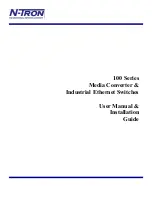
A-12
A2
TCP/IP socket communication is used when the client links to the unit. The
80xx and 90xx only supports VXI-11 commands via TCP and not via UDP.
The initial socket connection to an VXI-11 Instrument establishes the Core
channel which can handle multiple device links and locks. The client can create
an Abort channel to clear Core channel command hangups. The Abort channel
uses an additional TCP/IP socket. An Interrupt channel can be created from the
instrument, with the instrumentacting as an RPC client, to notify the application
that a Service Request (SRQ) has occurred. Interrupt channels share a separate
TCP/IP socket that does not count as one of the 15 Core or Abort sockets. If
the unit runs out of resources (sockets, links or locks), it blinks its RDY LED
until the shortage has been cured, typically by a socket or channel timeout.
The user normally links to the device's inst0 instrument interface. Interface
inst0 is typically used for all configuration and data transfer commands. Once
the link is made to inst0, the client can communicate with, control and query
the 80xx just as he would do with a standard GPIB test program. The client can
lock the link so that no other client can communicate with that instrument until
he is finished with it. Locking is only recommended if the device connection
is such that it could be operated by another user. Some VXI-11.3 instruments
have additional interfaces, inst1 to instn, that are used for other purposes. An
example is the 8063 which uses inst1 for transparent data transfer.
Sockets should be closed gracefully to prevent the VXI-11 Instrument from
running out of resources. Graceful socket closure requires several socket layer
messages between the client and server sockets. Most socket close commands
just ask the operating system to close the socket. The sockets often stay open
for tens of minutes until the operating system gets around to closing them. The
best way to close a socket is to do an immediate graceful socket closure instead
of just letting the operating system close the socket at some later time. Note
that if a connection is broken while one of its links is locked, the link stays
locked until either the broken connection is detected (by COMM_Timeout or
KeepAlive) or the unit is power cycled. Reconnecting from the same client
does not allow unlocking since the new connection is through a different socket.
The new socket has its own channels, links and locks and cannot manipulate
resources owned by another socket.
Two broken link discovery methods are COMM_Timeout and KeepAlive. The
COMM_Timeout setting allows the VXI-11 device to recover channels that
have not had any client activity for a set period of time. The KeepAlive setting
allows the VXI-11 device to test the client socket connection on a periodic basis.
When the device closes a socket, the socket and all of its resources (links and
locks) become available to another client.
Содержание 9099
Страница 20: ...1 16 1 Figure 1 1 9009 Outline Dimensions ...
Страница 24: ...1 20 1 Figure 1 3 9099 Certificate of Compliance ...
Страница 54: ...3 8 3 Figure 3 1 Status Reporting Structure Flash Configuration Reset ...
Страница 94: ...3 48 3 This page left intentionally blank ...
Страница 100: ...4 4 6 This page is left intentionally blank ...
Страница 161: ...A 49 A4 Refer to the ErrorLogger utility for the error value definitions Error Meaning 0 No error ...
















































